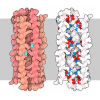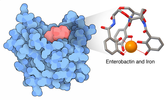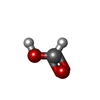Entry Database : PDB / ID : 3l33Title Human mesotrypsin complexed with amyloid precursor protein inhibitor(APPI) Amyloid beta A4 protein Trypsin-3 Keywords / / / / / Function / homology Function Domain/homology Component
/ / / / / / / / / / / / / / / / / / / / / / / / / / / / / / / / / / / / / / / / / / / / / / / / / / / / / / / / / / / / / / / / / / / / / / / / / / / / / / / / / / / / / / / / / / / / / / / / / / / / / / / / / / / / / / / / / / / / / / / / / / / / / / / / / / / / / / / / / / / / / / / / / / / / / / / / / / / / / / / / / / / / Biological species Homo sapiens (human)Method / / / / Resolution : 2.48 Å Authors Salameh, M.A. / Soares, A.S. / Radisky, E.S. Journal : J.Biol.Chem. / Year : 2010Title : Determinants of affinity and proteolytic stability in interactions of Kunitz family protease inhibitors with mesotrypsin.Authors : Salameh, M.A. / Soares, A.S. / Navaneetham, D. / Sinha, D. / Walsh, P.N. / Radisky, E.S. History Deposition Dec 16, 2009 Deposition site / Processing site Revision 1.0 Sep 22, 2010 Provider / Type Revision 1.1 Jul 13, 2011 Group
Show all Show less
 Yorodumi
Yorodumi Open data
Open data Basic information
Basic information Components
Components Keywords
Keywords Human mesotrypsin / alzheimer's amyloid precursor protein inhibitor /
Human mesotrypsin / alzheimer's amyloid precursor protein inhibitor /  APPI /
APPI /  Serine protease inhibitor / Hydrolase-Cell Adhesion complex
Serine protease inhibitor / Hydrolase-Cell Adhesion complex Function and homology information
Function and homology information regulation of Wnt signaling pathway / axo-dendritic transport / synaptic assembly at neuromuscular junction / smooth endoplasmic reticulum calcium ion homeostasis / axon midline choice point recognition / astrocyte activation involved in immune response / zymogen activation / regulation of spontaneous synaptic transmission / mating behavior / NMDA selective glutamate receptor signaling pathway /
regulation of Wnt signaling pathway / axo-dendritic transport / synaptic assembly at neuromuscular junction / smooth endoplasmic reticulum calcium ion homeostasis / axon midline choice point recognition / astrocyte activation involved in immune response / zymogen activation / regulation of spontaneous synaptic transmission / mating behavior / NMDA selective glutamate receptor signaling pathway /  ciliary rootlet / Lysosome Vesicle Biogenesis /
ciliary rootlet / Lysosome Vesicle Biogenesis /  PTB domain binding /
PTB domain binding /  Antimicrobial peptides / Golgi-associated vesicle / positive regulation of amyloid fibril formation / neuron remodeling / Insertion of tail-anchored proteins into the endoplasmic reticulum membrane / protein serine/threonine kinase binding / Deregulated CDK5 triggers multiple neurodegenerative pathways in Alzheimer's disease models / : / nuclear envelope lumen / suckling behavior / modulation of excitatory postsynaptic potential / presynaptic active zone / dendrite development / COPII-coated ER to Golgi transport vesicle / TRAF6 mediated NF-kB activation / Advanced glycosylation endproduct receptor signaling /
Antimicrobial peptides / Golgi-associated vesicle / positive regulation of amyloid fibril formation / neuron remodeling / Insertion of tail-anchored proteins into the endoplasmic reticulum membrane / protein serine/threonine kinase binding / Deregulated CDK5 triggers multiple neurodegenerative pathways in Alzheimer's disease models / : / nuclear envelope lumen / suckling behavior / modulation of excitatory postsynaptic potential / presynaptic active zone / dendrite development / COPII-coated ER to Golgi transport vesicle / TRAF6 mediated NF-kB activation / Advanced glycosylation endproduct receptor signaling /  Mitochondrial protein degradation / neuromuscular process controlling balance / The NLRP3 inflammasome / regulation of presynapse assembly / transition metal ion binding / intracellular copper ion homeostasis / regulation of multicellular organism growth / negative regulation of long-term synaptic potentiation / negative regulation of neuron differentiation / ECM proteoglycans /
Mitochondrial protein degradation / neuromuscular process controlling balance / The NLRP3 inflammasome / regulation of presynapse assembly / transition metal ion binding / intracellular copper ion homeostasis / regulation of multicellular organism growth / negative regulation of long-term synaptic potentiation / negative regulation of neuron differentiation / ECM proteoglycans /  smooth endoplasmic reticulum / endothelial cell migration /
smooth endoplasmic reticulum / endothelial cell migration /  trypsin / positive regulation of T cell migration / spindle midzone /
trypsin / positive regulation of T cell migration / spindle midzone /  Purinergic signaling in leishmaniasis infection / positive regulation of calcium-mediated signaling / forebrain development /
Purinergic signaling in leishmaniasis infection / positive regulation of calcium-mediated signaling / forebrain development /  clathrin-coated pit / regulation of peptidyl-tyrosine phosphorylation / positive regulation of chemokine production /
clathrin-coated pit / regulation of peptidyl-tyrosine phosphorylation / positive regulation of chemokine production /  Notch signaling pathway /
Notch signaling pathway /  digestion / positive regulation of G2/M transition of mitotic cell cycle / positive regulation of protein metabolic process / ionotropic glutamate receptor signaling pathway / neuron projection maintenance / serine-type peptidase activity / cholesterol metabolic process / response to interleukin-1 / positive regulation of glycolytic process / positive regulation of mitotic cell cycle / extracellular matrix organization /
digestion / positive regulation of G2/M transition of mitotic cell cycle / positive regulation of protein metabolic process / ionotropic glutamate receptor signaling pathway / neuron projection maintenance / serine-type peptidase activity / cholesterol metabolic process / response to interleukin-1 / positive regulation of glycolytic process / positive regulation of mitotic cell cycle / extracellular matrix organization /  axonogenesis / adult locomotory behavior / trans-Golgi network membrane / dendritic shaft / platelet alpha granule lumen / locomotory behavior / positive regulation of peptidyl-threonine phosphorylation /
axonogenesis / adult locomotory behavior / trans-Golgi network membrane / dendritic shaft / platelet alpha granule lumen / locomotory behavior / positive regulation of peptidyl-threonine phosphorylation /  learning / positive regulation of interleukin-1 beta production /
learning / positive regulation of interleukin-1 beta production /  central nervous system development / positive regulation of long-term synaptic potentiation / endosome lumen / astrocyte activation /
central nervous system development / positive regulation of long-term synaptic potentiation / endosome lumen / astrocyte activation /  Post-translational protein phosphorylation / positive regulation of JNK cascade / synapse organization / regulation of long-term neuronal synaptic plasticity / microglial cell activation / TAK1-dependent IKK and NF-kappa-B activation /
Post-translational protein phosphorylation / positive regulation of JNK cascade / synapse organization / regulation of long-term neuronal synaptic plasticity / microglial cell activation / TAK1-dependent IKK and NF-kappa-B activation /  visual learning / serine-type endopeptidase inhibitor activity /
visual learning / serine-type endopeptidase inhibitor activity /  neuromuscular junction / recycling endosome /
neuromuscular junction / recycling endosome /  cognition / positive regulation of inflammatory response / Golgi lumen / neuron cellular homeostasis /
cognition / positive regulation of inflammatory response / Golgi lumen / neuron cellular homeostasis /  endocytosis
endocytosis
 Homo sapiens (human)
Homo sapiens (human) X-RAY DIFFRACTION /
X-RAY DIFFRACTION /  SYNCHROTRON /
SYNCHROTRON /  MOLECULAR REPLACEMENT /
MOLECULAR REPLACEMENT /  molecular replacement / Resolution: 2.48 Å
molecular replacement / Resolution: 2.48 Å  Authors
Authors Citation
Citation Journal: J.Biol.Chem. / Year: 2010
Journal: J.Biol.Chem. / Year: 2010 Structure visualization
Structure visualization Molmil
Molmil Jmol/JSmol
Jmol/JSmol Downloads & links
Downloads & links Download
Download 3l33.cif.gz
3l33.cif.gz PDBx/mmCIF format
PDBx/mmCIF format pdb3l33.ent.gz
pdb3l33.ent.gz PDB format
PDB format 3l33.json.gz
3l33.json.gz PDBx/mmJSON format
PDBx/mmJSON format Other downloads
Other downloads https://data.pdbj.org/pub/pdb/validation_reports/l3/3l33
https://data.pdbj.org/pub/pdb/validation_reports/l3/3l33 ftp://data.pdbj.org/pub/pdb/validation_reports/l3/3l33
ftp://data.pdbj.org/pub/pdb/validation_reports/l3/3l33 Links
Links Assembly
Assembly



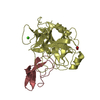
 Components
Components / Trypsin III / Brain trypsinogen / Mesotrypsinogen / Trypsin IV / Serine protease 3 / Serine protease 4
/ Trypsin III / Brain trypsinogen / Mesotrypsinogen / Trypsin IV / Serine protease 3 / Serine protease 4
 Homo sapiens (human) / Strain: BL21(DE3) / Gene: PRSS3, PRSS4, TRY3, TRY4 / Production host:
Homo sapiens (human) / Strain: BL21(DE3) / Gene: PRSS3, PRSS4, TRY3, TRY4 / Production host: 
 Escherichia coli (E. coli) / References: UniProt: P35030,
Escherichia coli (E. coli) / References: UniProt: P35030,  trypsin
trypsin
 Homo sapiens (human) / Gene: APP, A4, AD1 / Production host:
Homo sapiens (human) / Gene: APP, A4, AD1 / Production host: 
 Pichia pastoris (fungus) / References: UniProt: P05067
Pichia pastoris (fungus) / References: UniProt: P05067 Formic acid
Formic acid Water
Water X-RAY DIFFRACTION / Number of used crystals: 1
X-RAY DIFFRACTION / Number of used crystals: 1  Sample preparation
Sample preparation
 SYNCHROTRON / Site:
SYNCHROTRON / Site:  NSLS
NSLS  / Beamline: X12B
/ Beamline: X12B
 molecular replacement
molecular replacement Processing
Processing :
:  MOLECULAR REPLACEMENT / Resolution: 2.48→23.702 Å / Occupancy max: 1 / Occupancy min: 0 / FOM work R set: 0.843 / Stereochemistry target values: mlhl
MOLECULAR REPLACEMENT / Resolution: 2.48→23.702 Å / Occupancy max: 1 / Occupancy min: 0 / FOM work R set: 0.843 / Stereochemistry target values: mlhl Movie
Movie Controller
Controller



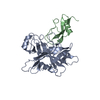



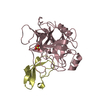
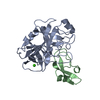

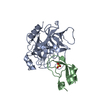




 PDBj
PDBj



